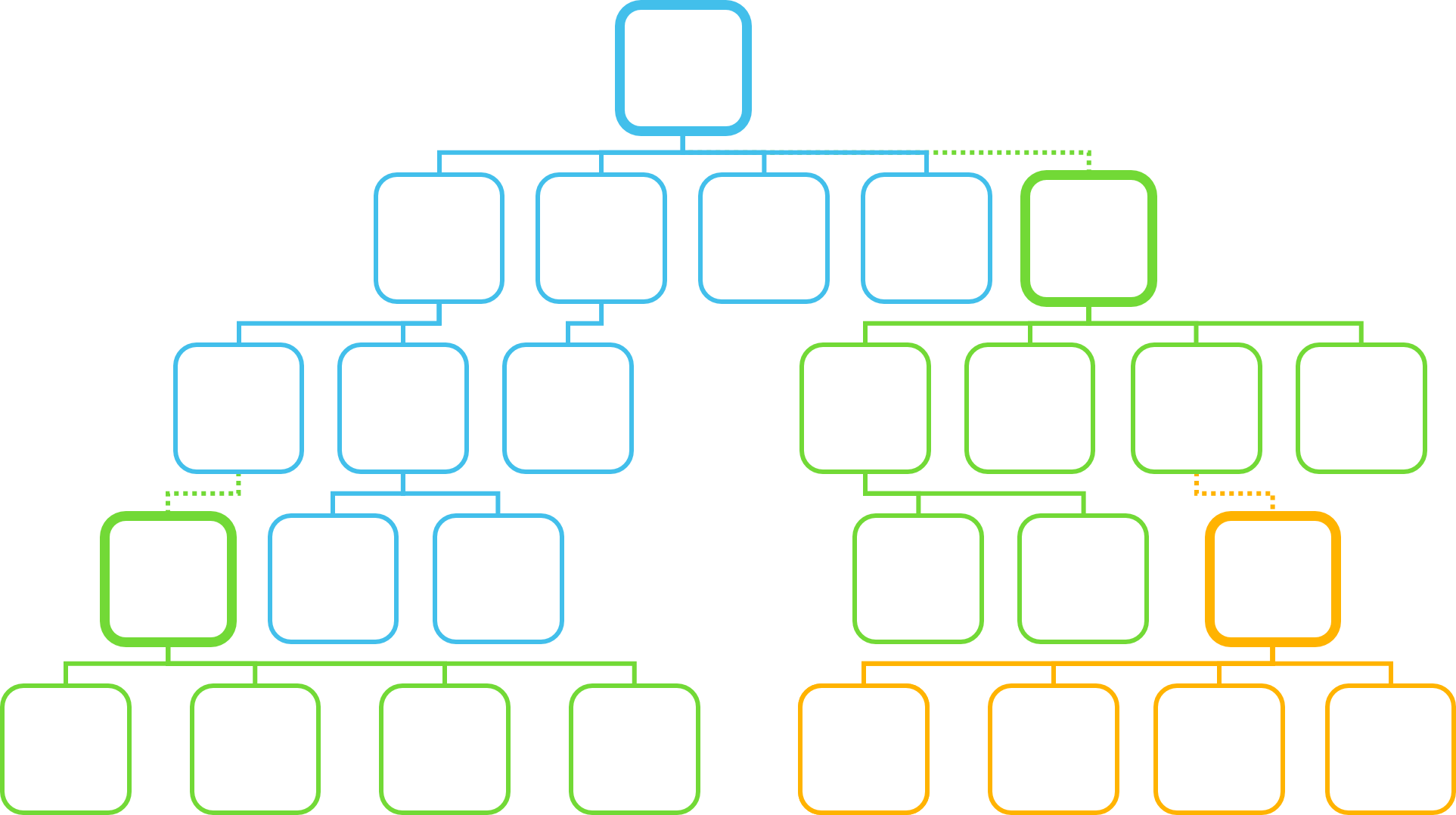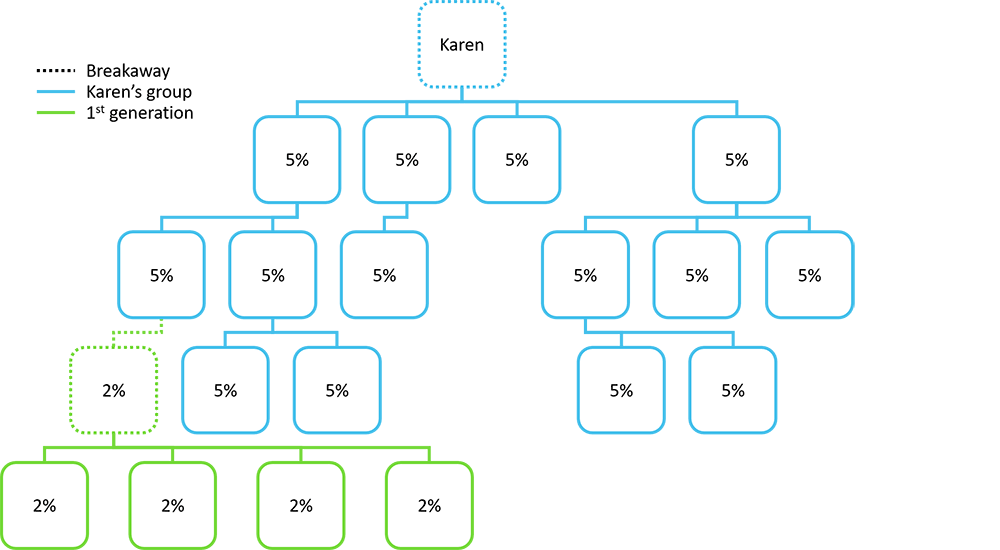SHARE
What’s a Breakaway Compensation Plan?

Breakaway compensation plans are the oldest of the three common compensation plan types. They’ve been around since the 1970s. To this day, they’re the most popular compensation plan among party plan companies. A breakaway compensation plan uses two primary bonuses and two defined sales force classifications: salespeople and sales leaders (also known as breakaway distributors). A breakaway compensation plan pays salespeople a commission on group volume and sales leaders a generation commission.
Salesperson commission paid on group volume
Salespeople earn a commission on their group volume. This is typically either a level commission or a stairstep differential commission. A level commission pays distributors a percentage on a certain number of levels of their downline. A stairstep commission is a type of differential commission comprised of progressive steps which have specific requirements. As distributors meet the requirements to climb the steps, they earn increasing percentages on their personal and group volume.
Groups are divided by breakaway distributors. Let’s say we have a breakaway distributor named Karen in the tree. Her group contains everyone beneath her who hasn’t reached the breakaway rank. When someone beneath her reaches a breakaway rank, that person literally breaks off into their own group. All the volume generated beneath the breakaway is now in that breakaway’s group.
Let’s say Karen is a salesperson just starting out. Here’s what her group looks like right now.
Here, Karen receives a level commission payout. She gets 5% on each member of her group. She’s inside the group of the breakaway above her but everything below her up until the next breakaway is her group for payout purposes. In a level commission, she gets a certain percentage on a certain number of levels. Here she qualifies for two levels and she get 5% on all the volume she qualifies for. If everyone in this tree generates $100 of personal volume (PV), she’ll get a $20 commission.
If this commission is a differential, the organization of the people in her group will have a complicated effect on how much she earns. You can read a more detailed explanation of differentials here. In brief, a differential commission pays Karen the percentage she qualifies for minus the percentages the people beneath her have already been paid. Here’s an example differential commission:
If I’m at rank 4, and a rank 1 beneath me generates $100 of volume, but there’s a rank 2 between me and that rank 1, I get 15% minus the rank 2’s 5%. Here’s Karen again, but now she’s getting a differential commission.
As a rank 3, she qualifies for 10% on all the rank 1s beneath her. But she’s blocked from getting paid on the volume from two of them because another rank 3 has already taken that 10%. If everyone generates $100 of volume, Karen gets $10.
Now let’s look at Karen’s commission if she becomes a breakaway.
Karen is now the breakaway distributor which means she’s at the top of the differential. She earns the full percentage she qualifies for on everyone on her first level. Beyond her first level, she earns the difference between what she qualifies for and what other distributors have already taken. She has a rank 1 beneath her with a rank 2 in between. The rank 2 takes 5%, leaving 15% for Karen. She has three rank 1s beneath her with a rank 3 in between. The rank 3 takes 10%, leaving Karen 10%.
The next breakaway beneath Karen is a rank 5, like her. She isn’t qualified to earn on his volume and, because he takes the remaining differential for the distributors beneath him, she doesn’t get a differential commission on any of them either.
Sales leader generation commission
As a sales leader, or breakaway distributor, Karen earns the group volume commission and she gets a generation commission. The generation commission pays a percentage on the group volume of breakaway distributors beneath her. Many companies call this a “sales leader override.” The percentage Karen earns on the generations beneath her is less than what she earns on her own group.
We’ve used a level group volume commission in this example for the sake of ease, but remember this is only one way to pay this bonus. Again, if everyone in this tree generates $100 PV, Karen gets a $45 commission on her group (5% of $900) and a $24 commission on her first generation (2% of $1,200), and a $5 commission on her second generation (1% of $500). These percentages are just examples—each plan will have its own specific rules for how much distributors get on each generation.
A breakaway/sales leader is always going to make more money on their immediate downline than they make on the breakaways/sales leaders in their downlines. On group volume, Karen may earn as much as 15-25%, and on her breakaway volume, she may earn as little as 3-6%.
Breakaway qualifications
The way that distributors qualify for the breakaway rank varies from company to company. In the example trees above, Karen qualifies by having four personally sponsored active first-level enrollees. If one of those four reaches the breakaway rank, she must enroll another active salesperson to retain her breakaway rank. Here’s an illustration of that process:
Distributors have to keep an eye on their organizations, anticipate when downline distributors are going to break away, and prepare accordingly to stay qualified. But even if Karen stays qualified as a breakaway, she’s going to lose some commission dollars when someone beneath her breaks off. Note that in the example above, the commission she received at the beginning was greater than the commission she received at the end. Let’s look at a more detailed example.
Figure 1 Commission before downline breakaway
Figure 2 Commission after downline breakaway
Karen’s organization grew, but her pay went down. This is a downside to the breakaway. The pay can change radically from month to month. This can frustrate your distributors but it also incentivizes them to continue enrolling and building their personal group.
Strengths of breakaway compensation plans
- Having one commission type for each of the types of distributors makes it much easier to set the percentages and qualifications. In other words, you can better take care of professional distributors of both kinds with this plan.
- The plan does a great job of paying salespeople. Of all the standard compensation plans, this one has the strongest potential in this area. Reaching the breakaway rank allows Karen to make a lot more money on her customers and brand-new distributors. Consequently, she has a lot more incentive to work with the people who need her help. On the people who have advanced to breakaway/sales leader, she’s now earning a smaller percentage. However, she gets paid down numerous levels of sales leaders—successful people—so she earns the commission on a lot of group volume.
- The plan uses level commissions for paying sales leaders. That is the most successful method for paying sales management commissions.
Weaknesses of breakaway compensation plans
- This plan is sometimes viewed as a compromise plan.
- Because many people—probably 90%—don’t build their own organization, they stay in other distributors’ personal groups.
- When two people in a line have the same rank, the differential is zero.
- This plan creates a treadmill effect: Each time Karen brings someone in, she has to qualify those group volumes, and as people break away, she has to replace that lost volume.
- They can be confusing and difficult to explain.

Want help designing your startup’s breakaway compensation plan? Reach out to us at MLM Compensation Consulting. We offer data-driven compensation plan design and analysis.
you may also like
Essential Software Customizations for MLM, Direct Selling, and Affiliate E-commerce
Navigating the changing landscape of e-commerce, particularly within MLM, direct selling, and affiliate marketing channels, requires more…
How to Ensure Your Compensation Plan and Software Work Well Together
Peanut butter and jelly. Milk and cookies. Batman and Robin. Everybody knows these famous pairings work well…
Podcast 53: Advantages Using an Interim VP of Sales for Direct Selling Companies
Today we welcome a returning guest of this podcast: Jeff Jordan. Jeff has also written articles for…
compensation consulting for mlm companies
We offer data-driven compensation plan design & analysis
MLM.com Newsletter
Get our e-mail newsletter, with MLM.com articles & online exclusives, delivered to your inbox each week.










